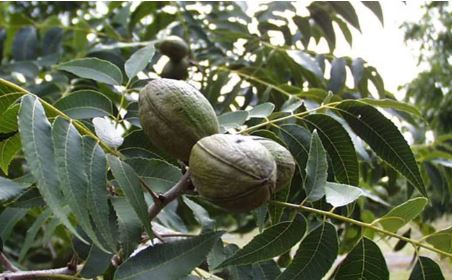
The pecan (Carya illinoinensis) is a species of hickory native to the southern United States and northern Mexico in the region of the Mississippi River. The tree is cultivated for its seed primarily in the U.S. states of Georgia, New Mexico, and Texas, and in Mexico. The word “pecan” is derived from an Algonquian word meaning “nut requiring a stone to crack.”
When Spanish explorers, including Hernando de Soto, ventured into what is now the southeastern United States in the 16th century, they encountered pecans. However, it wasn’t until the 17th century that the pecan was described by European explorers, with the first recorded mention by a French missionary, Jacques Marquette, in 1673.
Pecans were a staple in the diets of many Native American tribes, including the Caddo, Choctaw, and Cherokee. They used pecans not just for food but also for oil, which was extracted by boiling the nuts. The shells were used for fuel and as a tool for grinding other foods. The early 20th century brought scientific interest in pecan cultivation. The USDA began research into pecan breeding and disease resistance, leading to the development of many modern pecan cultivars.
Today, the tree is cultivated for its seed primarily in the U.S. states of Georgia, New Mexico, and Texas, and in Mexico. The seed is an edible nut used as a snack and in various recipes, such as praline candy and pecan pie. The pecan is the state nut of Alabama, Arkansas, California, Texas and Louisiana, and is also the state tree of Texas. They can be grown from USDA hardiness zones approximately 5 to 9, and grow best where summers are long, hot and humid. The nut harvest for growers is typically around mid-October.
Pecans are prone to infection by bacteria and fungi such as pecan scab, especially in humid conditions. Scab is the most destructive disease affecting pecan trees, untreated with fungicides. Recommendations for preventive spray materials and schedules are available from state-level resources. Various insects feed on the leaves, stems, and developing nuts. These include ambrosia beetles, twig girdlers, pecan nut casebearer, hickory shuckworm, phylloxera, curculio, weevils, and several aphid species.
Pecan trees are known for relatively fast growth in their youth, especially when provided with optimal conditions. Young trees can grow 2 to 3 feet (60 to 90 cm) per year or even more in ideal situations. As the tree matures, the growth rate slows down. However, with good care, Pecan trees can still add 1 to 2 feet (30 to 60 cm) in height annually for many years.
Under ideal conditions, they can live for 200 to 300 years or even longer. Some specimens are believed to have lived over 300 years. The trees start producing nuts around 6 to 10 years after planting, though significant commercial yields might not occur until they are 15 to 20 years old. They can remain productive for 100 years or more, with peak production often occurring between 30 to 75 years of age.

Biology and Characteristics
- Size: They can grow to be quite large, reaching heights of 100-140 feet.
- Leaves: Pecan leaves are pinnately ( they’re divided into multiple leaflets arranged along a central stem).
- Flowers: Both male and female flowers are found on the same tree, but they are separate.
- Nuts: The nuts are enclosed in a husk that splits open when they mature. The kernel inside is sweet and nutritious.
- Bark: The bark is ridged and gray, becoming deeply furrowed as the tree matures.
Cultivation
- Climate: Pecans thrive in warm, humid climates but are also grown in regions with cold winters, provided they have a long enough growing season.
- Soil: They prefer deep, well-drained soils but can adapt to various soil types if drainage is good.
- Pollination: Pecan trees are generally not self-pollinating; most cultivars require cross-pollination from another compatible variety.
Uses of Pecan Trees
- Food: The nuts are a popular snack and are used in various desserts, such as pies, cakes, and cookies.
- Oil: Pecan oil is extracted from the nuts and used for cooking and cosmetics.
- Wood: The wood is strong and durable and can be used for furniture, flooring, and other woodworking projects.
- Ornamental: Pecan trees make beautiful shade trees and can be planted in parks and gardens.
Challenges to Growth and Lifespan
- Environmental Stress: Pecans are susceptible to drought, flooding, and extreme temperatures, which can affect growth and longevity.
- Disease: Fungal diseases like pecan scab can significantly impact health and productivity if not managed.
- Urban Settings: In urban environments, Pecan trees might face challenges like limited space for root growth, pollution, and compacted soil, which can stunt growth and shorten lifespan.